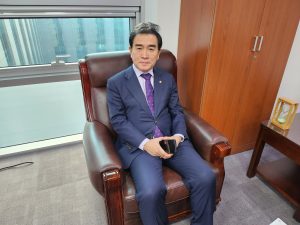Tensions remain high on the western coast of the Korean Peninsula. Over three days, starting on January 5, North Korea engaged in an artillery barrage, firing some 350 rounds near a disputed maritime border in the West Sea.
The incident led civilians on the border islands of Yeonpyeong and Baengnyeong to evacuate, as the South Korean military staged live-fire drills in response. For the islanders, it jogged memories of the bombardment of Yeonpyeong in 2010, which resulted in the death of four South Koreans: two civilians and two soldiers.
Reacting to the onslaught, South Korea’s Joint Chiefs of Staff on January 8 nullified maritime buffer zones in the West Sea, which had been created under a 2018 military pact signed between Seoul and Pyongyang.
North Korea’s menacing maneuvers come after its leader, Kim Jong Un, opened the new year vowing to annihilate South Korea and the United States if provoked. Concerns are brewing in the peninsula, as Kim may escalate aggression heading into South Korea’s general election in April.
In an interview with The Diplomat, Tae Yong-ho (sometimes spelled Thae Yong-ho), a lawmaker from the ruling People Power Party and ex-North Korean diplomat who defected to the South in 2016, deciphered Pyongyang’s intentions and what Washington and its allies should expect.
North Korea’s military activity is intensifying. Last December, they successfully launched a reconnaissance satellite and a Hwasong-18 ICBM. Their military maneuvers have become more direct in 2024. What is Kim Jong Un’s motive?
The recent artillery drills are Kim’s attempt to induce more palatable results in the upcoming general election in South Korea and the U.S. presidential election.
Kim is signaling to the U.S. presidential candidates that it’s time to renegotiate one-on-one with Pyongyang as it now possesses missiles capable of reaching the U.S. mainland. Simultaneously, Kim is laying the groundwork for Donald Trump’s potential return to the White House.
Turning to South Korea, Pyongyang is aware that its government no longer responds to tactical maneuvers such as launching ICBMs. So the recent artillery blast should be viewed as a shift in their strategy from utilizing advanced weapons to conventional weapons. The latter, most certainly, will garner an immediate and swift reaction as it could seriously endanger South’s citizens and infrastructures.
Kim is trying to craft a “war vs. peace” narrative leading up to South Korea’s April election to tilt the results in favor of the opposition Democratic Party – a party traditionally more dovish and cooperative toward the North. Simply put, Kim is conveying the message: If you back the ruling People Party Party, a conflict will be unavoidable.
Will North Korea scale up its military aggression before the two elections?
Not to a significant degree. Events like the Battles of Yeonpyeong (1999 and 2002) or the sinking of the Cheonan naval warship (2010) are highly unlikely today. South Korea’s military structure and chain of command have vastly changed. South Korea now has military capabilities and a command structure that would allow a prompt and overwhelming response.
That said, a murkier “grey zone” encroachment, say a cyberspace attack, cannot be excluded.
How will this affect the trilateral military partnership between the United States, South Korea, and Japan?
Pyongyang’s ultimate aim will be to undermine and rupture the “Camp David Framework” announced in August 2023.
The stark contrast between how Kim approaches Seoul and Tokyo is noteworthy. While Kim continues to take a scathing attitude vis-à-vis its neighbor to the South, he remains rather charitable to Japan.
Take, for instance, the condolence letter Kim sent to Japanese Prime Minister Kishida Fumio on January 5 over the recent earthquake. He referred to Kishida as “Your Excellency.” This is as rare an event as a North Korean leader sending a comfort message to its sworn enemy. Remember also, this happened the same day that North Korea open-fired some 200 artillery shells in the West Sea.
Pyongyang sees Japan as the weakest link in the trilateral pact. It also recognizes that Kishida is increasingly willing to negotiate over the abductee issue. Kim will likely capitalize on this situation to arrange a summit with the Japanese leader and attempt to isolate the archipelago from Washington and Seoul.
How will the U.S. presidential election in November play into this whole situation?
For Pyongyang, Trump’s reelection is more desirable than the incumbent Joe Biden administration, which carries on the Obama-era policy of strategic patience. While the 2019 Hanoi Summit ended fruitlessly, Kim believes he maintains a certain level of bond with the former president.
A recent Politico piece argued that Trump might shift America’s long-standing North Korea policy if reelected. Instead of a complete denuclearization, the article wrote that Trump may allow North Korea to retain its nuclear warheads with oversight but provide financial incentives to cease making new bombs.
Under the assumption of Trump’s return, Kim would likely seek bilateral negotiations with the U.S., offering to ease its military threat against the country.
If Trump, during his second term, desires to repivot America’s focus to China, the offer should be an entertaining one. But for South Korea, it’s an undesirable scenario.
Pyongyang recently repositioned its stance toward South Korea. What is your assessment?
There has indeed been a critical shift in Pyongyang’s policy vis-à-vis South Korea. Kim’s regime recently declared South Korea a “principal enemy” and abandoned all possibility of reunification or reconciliation. For North Korea, the South is now a belligerent state.
The restructuring of the policy should be interpreted as Kim paving the way for Pyongyang’s potential use of nuclear weapons against South Korea, a combative state in their view, in the event of an armed conflict.

































